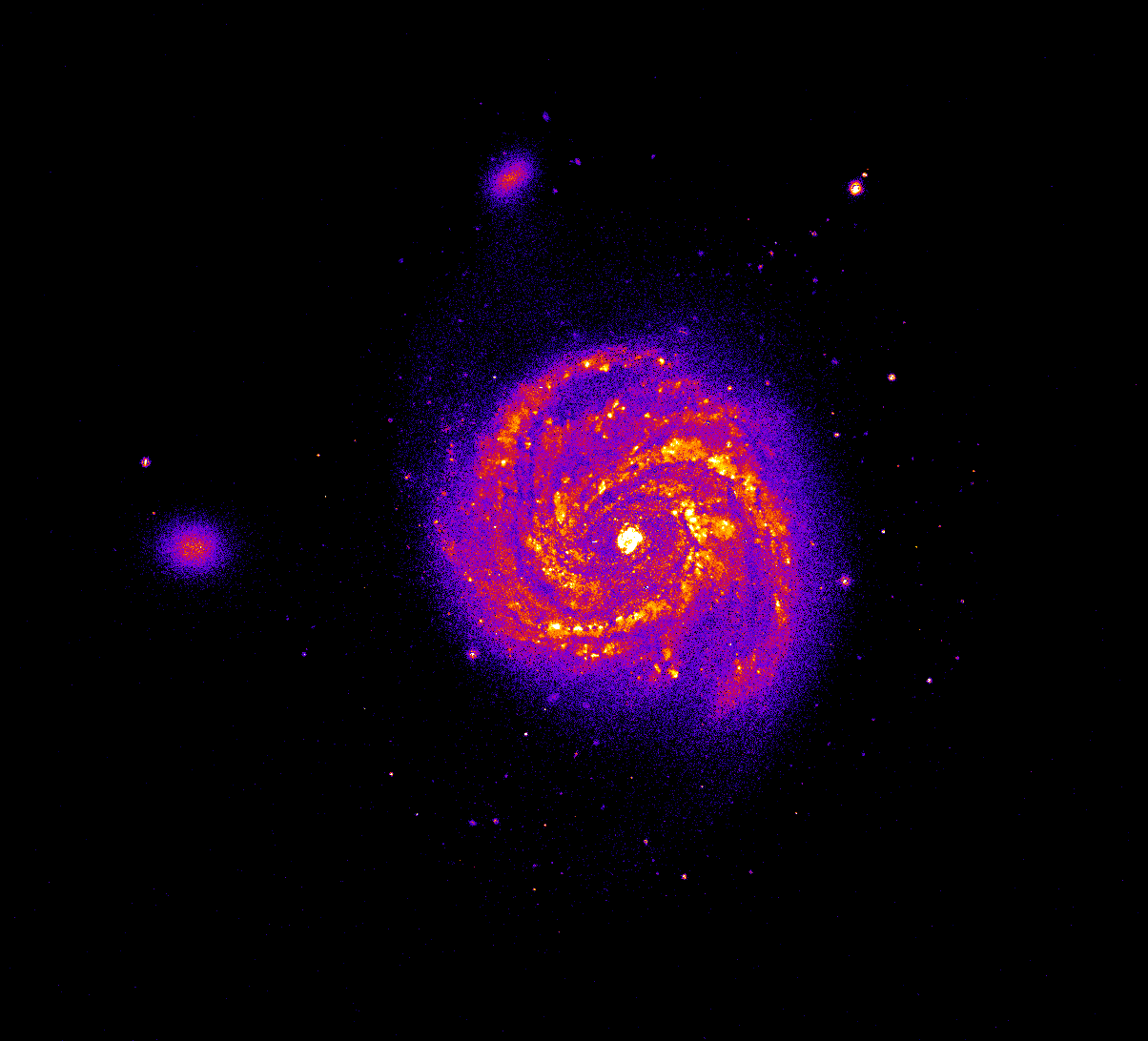TheSkyNet – T2 is born
Celebrating two years of successful citizen astronomy research
TheSkyNet is celebrating its two year anniversary today with the official launch of a new research project, as well as a range of improvements and new features to make contributing to astronomical research at home more enjoyable, and even easier.

An image of galaxy M100 processed by theSkyNet POGS volunteers. This processed image shows how fast stars are forming the galaxy, with the bright orange and white areas where many stars are forming and the darker areas where fewer are forming. Image Credit: Kevin Vinsen, ICRAR and Dave Thilker, Johns Hopkins University.
Launched on September 13th 2011, theSkyNet is a community computing project dedicated to astronomy, initiated by the International Centre of Radio Astronomy Research (ICRAR) in Perth, Western Australia.
By using the idle processing power of thousands of computers connected to the Internet, theSkyNet simulates a powerful single machine and processes data collected by telescopes around the world.
Today theSkyNet launches T2 – Transform 2 – a new version of its website that brings new citizen science and membership features. At theskynet.org members can view the credits they’ve earned by processing data, trophies they’ve been awarded as part of their contribution, the actual galaxies they’ve processed data from and can join alliances to process together.
As part of T2, theSkyNet is also officially launching a new scientific project – theSkyNet POGS, which started testing almost a year ago. TheSkyNet Pan-STARRS1 Optical Galaxy Survey, or theSkyNet POGS, processes data gathered by various telescopes around the globe to measure the properties of thousands of galaxies, such as stellar mass and star formation rate.
TheSkyNet POGS is the first-ever Australian project to be available to the public on the popular distributed computing software BOINC.
“Today marks the official launch of theSkyNet POGS, and its integration into theSkyNet’s main website, where users can now view their stats, as well as the stunning galaxy images their computer has helped process,” said theSkyNet Project Scientist Kevin Vinsen.
Thanks to some 3500 users, and with 50 more joining every day, theSkyNet POGS has already processed an impressive 7000 galaxies since it started testing; and as the number of computers in the project grows with its official integration into the website, the team behind it aims to process over 100,000 galaxies.
“Processing this amount of data with a research computer would normally take 10 years, but the way theSkyNet POGS is going we’ll be done in less than three,” said Vinsen.
T2 also sees a raft of new features on theSkyNet’s completely revised website. TheSkyNet members earn credits as they process data, either individually or as part of alliance. As members earn credits and climb up the rankings, they accumulate unique trophies and rewards as an incentive to participate.
As part of its second anniversary celebrations, TheSkyNet has developed a whole new range of trophies for its members, as well as adding the images of the galaxies they have processed to the website, which users can download as part of individual galaxy reports showing their contribution.
“We are introducing one of the most extensive systems of user statistics in the distributed computing world,” said Alex Beckley, theSkyNet web developer. “Users will be able to see how much they are really contributing to science, and will be able to map the actual galaxies they have worked on in the sky, something that’s exclusive to theSkyNet.”
Since its launch two years ago, theSkyNet has increased to over 11,000 members processing data for astronomers, donating the equivalent of a mid level supercomputer to science. TheSkyNet now crunches at between 20 and 35 TFLOPS.
In its first two years, theSkyNet focussed on its original project – theSkyNet SourceFinder – which processes radio astronomy data to find and map new sources of radio waves for astronomers to study. In that time, theSkyNet SourceFinder has optimised the way systems automatically search for radio sources in astronomy data. Because of theSkyNet SourceFinder’s work, future data from telescopes like CSIRO’s Australian SKA Pathfinder (ASKAP) will only need a tenth as much processing to find all the radio sources.
TheSkyNet SourceFinder continues to process simulated radio astronomy data to help refine this process even further, hoping to cut processing time for the next generation of radio telescopes down even more.
“Our members are an amazing group, the combined computing power they donate would cost hundreds of thousands of dollars if purchased from a supercomputer. We’re incredibly grateful for their efforts,” said Vinsen.
“In recent years, distributed computing has emerged as a powerful way for the public to help researchers process the vast amounts of data collected by their experiments.”
“In astronomy, as ever bigger arrays of telescopes conduct vast surveys of the sky, huge amounts of data are collected that impose new challenges for the science community. Solving this Big Data problem is one of the core areas of study at ICRAR. We’re helping develop the infrastructure needed to transport, store and process the data from next generation telescopes such as the Murchison Widefield Array, CSIRO’s ASKAP, and the future SKA,” said Vinsen.
TheSkyNet is already working on making other research projects available to its members, such as processing actual data from ASKAP and solar data from the recently launched Murchison Widefield Array (MWA) SKA precursor.
Image

An image of galaxy M100 processed by theSkyNet POGS volunteers. This processed image shows how fast stars are forming the galaxy, with the bright orange and white areas where many stars are forming and the darker areas where fewer are forming. Image Credit: Kevin Vinsen, ICRAR and Dave Thilker, Johns Hopkins University.
Contacts
Kevin Vinsen
Project Scientist, theSkyNet
Ph: +61 8 6488 7743
M: +61 435 164 060
E: kevin.vinsen@icrar.org
Alex Beckley
Web Developer, theSkyNet
Ph: +61 8 6488 7745
M: +61 419 919 996
E: alex.beckley@icrar.org
Kirsten Gottschalk
Media Contact, ICRAR
Ph: +61 8 6488 7771
M: +61 438 361 876
E: kirsten.gottschalk@icrar.org

